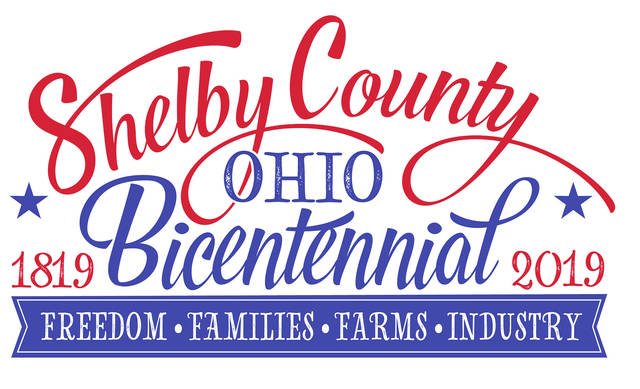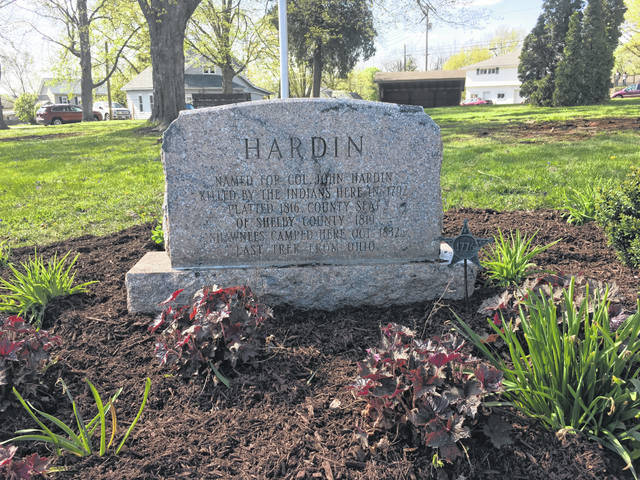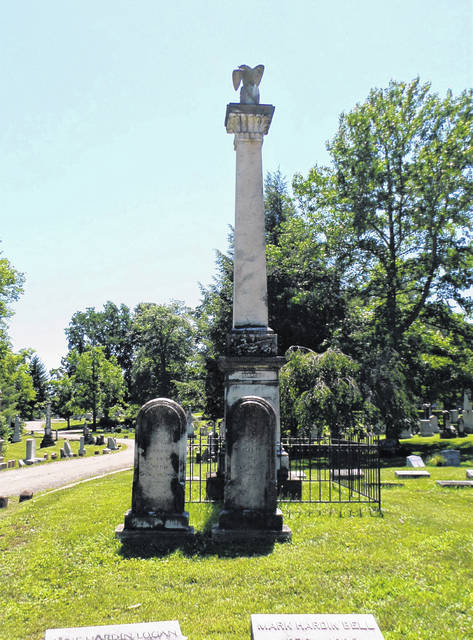


Editor’s note: in conjunction with the 200th celebration of the establishment of Shelby County, the Sidney Daily News will be publishing a year long series about the county’s history.
SIDNEY — John Hardin was born Oct. 1, 1753, in Prince William County (now Fauquier County), Virginia. The second son and sixth child of Martin (1716-1778) and Lydia (Waters) Hardin (1721-1800), John’s s siblings included Mary (1741-1780), Sarah (1743-1826), Hannah (1745-1784), Lydia (1748-1791), Mark (1750-), Catherine (1755-), Martin (1757-1848) and Rosannah (1760-1789).
The senior Martin Hardin operated a tavern at Elk Run and was a member of the Virginia militia. Although John did learn to read and write, there were few educational opportunities at Elk Run. As a result, John spent much of his time roaming the wooded terrain surrounding his father’s tavern. John became increasingly proficient at tracking and even at an early age, an expert marksman with a rifle.
Martin sold his tavern and moved with his family and a couple of his siblings to Monogahela County (then claimed by Virginia although part of Pennsylvania) when John was 12 years of age. They settled at George’s Creek. Because they were living on the frontier, there were no opportunities for additional schooling. John spent nearly all of his time in the woods, where he would daily take enough game to feed not only the Hardin family, but two neighboring families as well.
John’s reputation as a marksman became the talk of the frontier. That reputation caused Captain Zack Moran to ask Hardin to join his company in 1774 with the rank of ensign. The company joined the fight against hostile Indians during Lord Dunmore’s War.
Hardin was a fierce fighter, earning the moniker of “Indian Killer.” He was wounded in the groin at the Battle of Point Pleasant (Oct. 10, 1774), and carried the offending musket ball with him for the remainder of his life.
At the conclusion of Lord Dunmore’s War, the Indians signed the Treaty of Camp Charlotte (Oct. 19, 1774). Under the provisions of the treaty, the Shawnee gave up all lands east and south of the Ohio River, agreed to no longer attack colonists traveling down the Ohio River, and agreed to return all white captives.
With the advent of the Revolutionary War, Hardin entered the Continental Army joining the 8th Pennsylvania as a second lieutenant. Known as The Provisional Rifle Corps or Morgan’s Rifles, the unit was led by Col. Daniel Morgan. Hardin was one of the heroes of the Battle of Saratoga. The battle, considered the turning point of the war, resulted in British General John Burgoyne surrendering his huge army on Oct. 16, 1777.
Hardin continued serving in the Continental Army until December 1779, when he resigned his commission. He was offered a promotion to the rank of major in a new regiment that was being formed, but he declined to accept it, likely because he had fallen in love.
Hardin married Jane Daviess in 1779 in Culpeper County, Virginia. Their first child, Martin Davis, was born June 21, 1780 (and died in 1823). Their second son (Mark) was born June 21, 1782 (and died in 1875). Davis (1784-1886), John (1785-1807) Mary (1786-1823), Lydia Ann (1788-1790), and Rosanna 1791-1865) followed.
Hardin went to Kentucky in search of land on which to settle. His trip is of historic value because he is the first to retrace the steps of Daniel Boone. He ultimately moved to Nelson County, Virginia (now Washington County, Kentucky) in 1786. He settled on Pleasant Run, near Springfield. Several of his siblings joined him. Martin settled approximately three miles from John, Lydia settled, about four miles further, and Mark settled about four miles further still.
John Hardin became a successful farmer and rancher. He joined the Methodist Church, and was a captain of the local militia.
In 1786, Hardin led a successful attack on a Piankeshaw village near present-day Vincennes, Indiana. In August 1789, he led another successful militia expedition attacking a Shawnee village near present-day Terre Haute, Indiana. He returned to Kentucky with twelve scalps.
As a result of his success, Hardin was promoted to colonel. Hardin repeatedly engaged Indians during a series of campaigns in the Ohio Territory, referred to in historical texts as the Northwest Indian War. He was a part of the army assembled by Gen. Josiah Harmar that, in 1790, moved against the Miamis, the Shawnee, and the Lenape living in western Ohio.
The Indians in the region fled their villages as Harmar’s army approached. The Americans burned several villages, but the Indians regrouped. On Oct. 19, Hardin led his men into an ambush in the disastrous Battle of Heller’s Corner. Known as “Hardin’s Defeat,” Hardin’s force consisted of several hundred militiamen and a few regular soldiers. Most of the militiamen fled the battle without even firing a shot. The regular soldiers put up a brief but futile resistance. Some of the retreating militiamen did not stop running until they crossed the Ohio River into Kentucky.
The Battle of Heller’s Corner began a long series of American losses to the Miami War chieftain Meshekinnoquah (Little Turtle). Two days after Hardin’s defeat, Harmar sent out another detachment against the Miami. Once again, the Indian forces under Little Turtle inflicted heavy casualties upon the army. Harmar immediately retreated to the safety of Fort Washington, having lost 183 men killed or missing in this campaign.
In 1791, Hardin led a force of 60 mounted Kentucky mounted militia to the mouth of Big Pine Creek. There they destroyed a large Kickapoo village as a part of Gen. Charles Scott’s campaign to destroy Ouiatenon.
According to a 1790 U.S. government report, 1,500 Kentucky settlers had been killed in Indian raids since the end of the Revolutionary War. In an attempt to end the raids, Gen. George Rogers Clark led an expedition of 1,200 drafted men against Native American villages along the Wabash River in what was then Illinois County, Virginia. Hardin served as quartermaster for the force. The campaign ended without a victory, but Clark was able to negotiate a ceasefire with the native tribes.
In April 1792, President George Washington relayed word to Hardin through Gen. James Wilkinson asking him to negotiate a peace with the Shawnee. Hardin was to travel northward to the Upper Sandusky River. The messaged he carried contained what had become standard language for such missions, and read in part:
“To all the tribes south of the (Great) Lakes, east of the Mississippi and northwest of the Ohio (river):
Brothers – The President of the United States (George Washington) entertains the opinion, that the war which exists is founded in error and mistake on your part. That you believe that the United States wants to deprive you of your lands and drive you out of the country. Be assured that this is not so; on the contrary, that we should be greatly gratified with the opportunity of imparting to you all the blessings of civilized life, of teaching you to cultivate corn, to raise oxen, sheep and other domestic animals; to build comfortable houses; so as ever to dwell upon the land.”
Before Hardin left the protection of Fort Washington in June 1792, he wrote a note to his wife to reassure her that his life would not be in danger. He wrote:
“The Indians have killed several persons in the quarter lately and leave behind them war clubs, which denotes their intentions of war. But do not let this give you any uneasiness as I have not a doubt that I shall meet with good treatment, as the speech and the belt I shall take is from the president of the United States.”
Hardin’s party included a guide and interpreter named John Flinn and a servant known to history only as Freeman. Flinn was qualified as an interpreter because he and his entire family were captured and spent 14 years living with the Indians in Virginia.
Hardin headed north from Cincinnati and was within three quarters of a mile of the current hamlet of Hardin in Shelby County, Ohio when they were intercepted by a party of Shawnee Indians. The group offered to escort Hardin and his party to their village. The details of what happened to the Hardin party was later revealed by Chief Blackhoof, of the Shawnee Nation soon after the peace of 1795 and recorded in the notes of Col. John Johnston.
The story as told by Chief Blackhoof explained the Shawnee Indian party had learned of Col. Hardin’s mission and interpreted it as anything but peaceful. The Indians determined to lure Hardin into a trap by feigning friendship after which they would offer to camp the night with the white men and then kill them while they slept.
Hardin agreed to camp with the Indians hoping to demonstrate the trust and friendship he hoped to garner on his mission. That night the Shawnee waited until the party went to sleep, then murdered Hardin and his companions except Flinn, whose life was spared since he had lived many years with the Indians.
The actual date of Hardin’s murder is unknown, although the date is set at May 2, 1792, based on Chief Blackhoof’s account. Hardin’s body was not recovered for some time. He was scalped, and his clothes and equipment stolen. It is unknown as to whether his body was also mutilated, as it is probable that at least a part of the damage to his body was caused by wild animals.
Hardin’s remains were eventually buried in Shelbyville, Kentucky. John Hardin’s son Martin Hardin, who served for some years as the Speaker of the Kentucky House of Representatives, later had an imposing monument erected at the site of his father’s grave.




